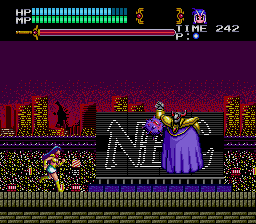Another Valis game, another threat to peace in the Dream World. This time it’s the dictator of the newly introduced World of Spirits, Ramses (originally Glames in the Japanese version). His world is dying, and so he declares war on Vecanti and Earth to secure his people’s survival. Or so he claims, but it’s all a scam: The thing is, he owns a counterpart to the Sword of Valis called the Sword of Lassas, and the two were once used in a combined effort of the Dream and Spirit world to slay a giant sent as punishment by the gods. Bringing the two swords together would grant their wielder Ultimate Power, so naturally he wants the Valis Sword really bad.
Also after the Sword of Valis is the horned demon girl (how come only the women don’t look like Gundam robots?) Cham, but to free her people of Ramses’ tyranny. So she sneaks into Yuko’s room at night and steals it, but then gets abducted by one of Ramses’ mooks. Yuko of course gets back her sword, slays the demon, and the two girls decide to stick it to Ramses together.
Valis III is the point where the series finally got kinda good. In part that’s owed to the tight controls (apart from the awkward up + jump button high jump) and above average level design, but the game’s most flashy feature is the ability to switch between several characters by the press of a button, and each of them has a different weapon. Yuko settles on one type of energy wave, but it needs to charge up for a split second after each attack to reach its full range. Cham is pretty much the official Castlevania tribute character, as she wields a whip that works exactly like the Belmonts’ family weapon. Soon, the two free princess Valna from being enclosed in a crystal, and she shoots magical charges from her wand, which gain a wider spread as it gets upgraded.
Each of them also has individual appliances for each of the three spells available – lightning, fire and ice. The latter actually freezes enemies, which can then be used as a platform. The choice of character even results in different dialog when facing the bosses, but then character switching is locked during the fight, and there are also a few stages that demand for one certain heroine (mostly Yuko). This is also where the ground slide is first introduced, which is available to all three of them, and not only helps to dive through low ceilings and get onto otherwise unreachable platforms, but also doubles as an emergency getaway attack.
At the time of its release, Valis III was by far the most versatile, fun and best-looking game in the series. It was soon ported to the Sega Genesis – and this time it truly is a conversion of the same game and not an entirely different one – but seriously downsized for a measly 1MB cartridge. Not only most of the cinematic scenes have been cut and some of them replaced with text only dialog, but there’s also a whole bunch of stages gone from this release. Granted, the Genesis also got one exclusive new stage, but that’s nothing compared to the four or five that went missing. The remaining stages are almost exactly the same, although some backgrounds have been changed for slightly more effective parallax scrolling. If the Genesis version has one thing going for it, it’s the improved boss fights. The best example of this is the water dragon, which merely sticks its head out of the lake to attack the heroines’ boat on the TurboGrafx-16, but actually starts flying around on the Genesis.


